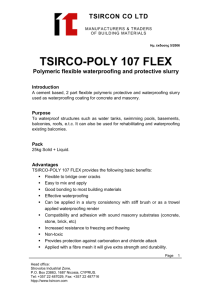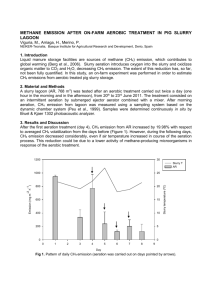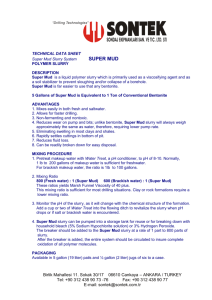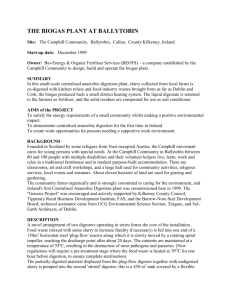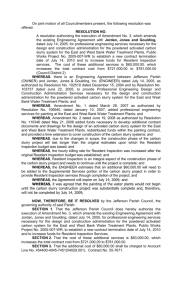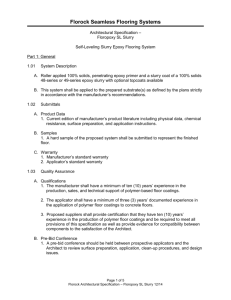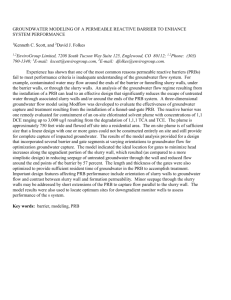Journal of Ceramic Processing Research. Vol. 15, No. 2, pp
advertisement
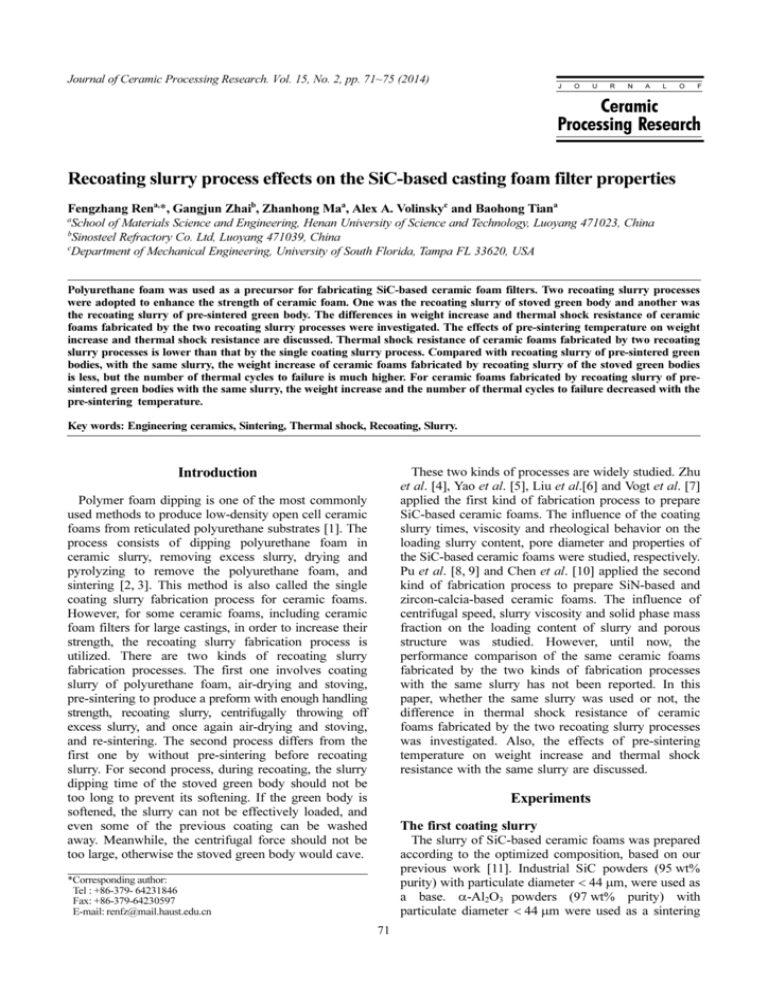
Journal of Ceramic Processing Research. Vol. 15, No. 2, pp. 71~75 (2014) J O U R N A L O F Ceramic Processing Research Recoating slurry process effects on the SiC-based casting foam filter properties Fengzhang Rena,*, Gangjun Zhaib, Zhanhong Maa, Alex A. Volinskyc and Baohong Tiana a School of Materials Science and Engineering, Henan University of Science and Technology, Luoyang 471023, China Sinosteel Refractory Co. Ltd, Luoyang 471039, China c Department of Mechanical Engineering, University of South Florida, Tampa FL 33620, USA b Polyurethane foam was used as a precursor for fabricating SiC-based ceramic foam filters. Two recoating slurry processes were adopted to enhance the strength of ceramic foam. One was the recoating slurry of stoved green body and another was the recoating slurry of pre-sintered green body. The differences in weight increase and thermal shock resistance of ceramic foams fabricated by the two recoating slurry processes were investigated. The effects of pre-sintering temperature on weight increase and thermal shock resistance are discussed. Thermal shock resistance of ceramic foams fabricated by two recoating slurry processes is lower than that by the single coating slurry process. Compared with recoating slurry of pre-sintered green bodies, with the same slurry, the weight increase of ceramic foams fabricated by recoating slurry of the stoved green bodies is less, but the number of thermal cycles to failure is much higher. For ceramic foams fabricated by recoating slurry of presintered green bodies with the same slurry, the weight increase and the number of thermal cycles to failure decreased with the pre-sintering temperature. Key words: Engineering ceramics, Sintering, Thermal shock, Recoating, Slurry. These two kinds of processes are widely studied. Zhu et al. [4], Yao et al. [5], Liu et al.[6] and Vogt et al. [7] applied the first kind of fabrication process to prepare SiC-based ceramic foams. The influence of the coating slurry times, viscosity and rheological behavior on the loading slurry content, pore diameter and properties of the SiC-based ceramic foams were studied, respectively. Pu et al. [8, 9] and Chen et al. [10] applied the second kind of fabrication process to prepare SiN-based and zircon-calcia-based ceramic foams. The influence of centrifugal speed, slurry viscosity and solid phase mass fraction on the loading content of slurry and porous structure was studied. However, until now, the performance comparison of the same ceramic foams fabricated by the two kinds of fabrication processes with the same slurry has not been reported. In this paper, whether the same slurry was used or not, the difference in thermal shock resistance of ceramic foams fabricated by the two recoating slurry processes was investigated. Also, the effects of pre-sintering temperature on weight increase and thermal shock resistance with the same slurry are discussed. Introduction Polymer foam dipping is one of the most commonly used methods to produce low-density open cell ceramic foams from reticulated polyurethane substrates [1]. The process consists of dipping polyurethane foam in ceramic slurry, removing excess slurry, drying and pyrolyzing to remove the polyurethane foam, and sintering [2, 3]. This method is also called the single coating slurry fabrication process for ceramic foams. However, for some ceramic foams, including ceramic foam filters for large castings, in order to increase their strength, the recoating slurry fabrication process is utilized. There are two kinds of recoating slurry fabrication processes. The first one involves coating slurry of polyurethane foam, air-drying and stoving, pre-sintering to produce a preform with enough handling strength, recoating slurry, centrifugally throwing off excess slurry, and once again air-drying and stoving, and re-sintering. The second process differs from the first one by without pre-sintering before recoating slurry. For second process, during recoating, the slurry dipping time of the stoved green body should not be too long to prevent its softening. If the green body is softened, the slurry can not be effectively loaded, and even some of the previous coating can be washed away. Meanwhile, the centrifugal force should not be too large, otherwise the stoved green body would cave. Experiments The first coating slurry The slurry of SiC-based ceramic foams was prepared according to the optimized composition, based on our previous work [11]. Industrial SiC powders (95 wt% purity) with particulate diameter < 44 μm, were used as a base. α-Al2O3 powders (97 wt% purity) with particulate diameter < 44 μm were used as a sintering *Corresponding author: Tel : +86-379- 64231846 Fax: +86-379-64230597 E-mail: renfz@mail.haust.edu.cn 71 72 Fengzhang Ren, Gangjun Zhai, Zhanhong Ma, Alex A. Volinsky and Baohong Tian aid, adding 16.5 wt% of SiC. Refractory clay with particulate diameter < 74 μm was used as a plasticizer, adding 3.5 wt% of SiC. Silica sol (50% SiO2 content) and dextrin (particulate diameter < 74 μm) were mixed in 2 : 1 weight proportion as a compound binder. The quantity of the compound binder was 10% of SiC amount. Water added was about 39% of the SiC weight. The content of solid phases (SiC, Al2O3, dextrin and refractory clay) in the compound slurry was about 72.8%. Commercial polyurethane foam with cell size of approximately 6 pores per inch (ppi) was cut into 50 mm × 50 mm × 20 mm pieces as precursors to fabricate SiC-based ceramic foam filters for casting. The surface of the precursors was activated by a polyethyleneimine aqueous solution (2.5% concentration). The precursors were immersed in the compound ceramic slurry. Then the precursors with slurry were rolled to remove excess slurry. After being air-dried for 24 h and stoved at 110 oC for 24 hrs, some of the coated precursor substrates (stoved green bodies) were sintered and presintered, respectively, to fabricate the ceramic foams and preforms (pre-sintered green bodies). Recoating slurry (the second coating slurry) The slurry composition for recoating was the same as that of the first coating, and added water amount was the same or not (i.e., total solid phase content was the same or different). Two kinds of different recoating slurry processes were applied. The preforms (first process) and the stoved green body (second process) were respectively recoated by slurry, and then excess slurry was centrifugally removed. The specific testing programs were as follows. Testing program 1: The same slurry (solid phase content was about 72.8%, i.e. the slurry was the first coating slurry) and the same centrifuge rotational speed were used for the two recoating slurry processes. After recoating slurry, the recoated green bodies and the recoated preforms (pre-sintering process of the preforms was 1400 oC × 1 hr) were finally sintered. The weight increase percentage (contrast with the ceramic foams fabricated with a single coating) and the thermal shock resistance of ceramic foams fabricated by two kinds of recoating slurry processes with the same slurry were investigated. Testing program 2: Two different slurries (added water quantity was different, solid phase percentage was different) and two different centrifuge rotational speeds were used for the two recoating slurry processes. The loading contents of recoating slurry were kept roughly identical (the weight of fabricated ceramic foams was basically identical too) for the two recoating slurry processes (pre-sintering process of the preforms was 1400 oC × 1 hr). Thermal shock resistance and water absorption rate of the fabricated ceramic foams by two kinds of recoating slurry processes under the same loading content of slurry were investigated. Testing program 3: The stoved green bodies were sintered at 1000oC, 1100 oC, 1200 oC, 1300 oC, and 1400 oC, respectively, for 1 hr to prepare the preforms. The different preforms were coated by the same slurry (70.9% solid phase content) at the same centrifugal speed, and finally sintered. The weight increase percentage (contrast with the ceramic foams fabricated with a single coating) and thermal shock resistance of ceramic foams fabricated by recoating slurry with the same slurry and the same centrifugal speed, but different pre-sintering temperature, were investigated. Testing program 4: By using different slurry (different added water amount) and different centrifugal speed, the stoved green bodies, after pre-sintering at 1000 oC, 1100 oC, 1200 oC, 1300 oC, and 1400 oC, respectively for 1 hr, proceeded to recoat slurry. The loading content of slurry was kept roughly identical. The thermal shock resistance and water absorption rate of the finally fabricated ceramic foams under identical loading content of slurry with different pre-sintering temperature were investigated. Final sintering process The first recoating slurry fabrication process of ceramic foams, where the preforms were recoated with slurry and then were sintered to ceramic foams, contains two sintering steps. The second recoating slurry fabrication process of ceramic foams, where the stoved green bodies directly proceeded to recoat slurry and then were sintered to ceramic foams, contains only one sintering. The heating curve of the first sintering should be different from that of the second sintering. Both polyurethane foam and dextrin are organic materials, which combusted producing a great deal of gas. This gas released by burning organics did not readily diffuse through the green bodies within a short time to cause a large amount of pores and cracks, so the heating rate of the first sintering could be appropriately managed according to the combustion characteristics of the organics. The combustion characteristics of polyurethane foams and dextrin were investigated by means of differential scanning calorimetry and thermogravimetric analysis with a STA 409PC simultaneous thermal analyzer of Netzsch Inc. Polyurethane foams started burning at about 200 oC, burnt fiercely in the 200 oC to 440 oC range, later burnt slowly and no longer burnt until 600 oC. Dextrin began to burn from 50 oC, burnt drastically in the 300 oC to 340 oC range, and until 420 oC burning basically stopped. During the first sintering with slow heating from 200 oC to 600 oC, gas could slowly diffuse out from the green bodied, and a heating rate of 1 oC • min−1 was chosen for testing. During the second sintering, the heating process must be slow from 200 oC to 420 oC and the heating rate of 1 oC • min−1 was also used. The heating rate was not Recoating slurry process effects on the SiC-based casting foam filter properties 73 controlled during the other heating stage. The final sintering temperature was 1400 oC, and the holding time of ceramic foams fabricated by single sintering and dual sintering was 1.5 hr and 1 hr, respectively. Physical properties testing Compressive strength at room temperature was measured using a Shimdzu AG-1250KN tensile testing machine. 2 mm thick rubber sheets were placed underneath and on top of the sample, compressed with a 25 mm diameter steel cylinder head. The ceramic foam was compressed until it was crushed with the maximum load recorded, yielding its compressive strength. While there are standards for testing ceramics in compression [12, 13], highly porous ceramics are challenging to test, thus rubber sheets were used to prevent the local porous structure crushing underneath the compression tester steel cylinder head. The samples were (1) heated up to 1100 oC, held for 15 min, and then (2) quenched immediately in tap water. By repeating the above two steps, the number of thermal cycles, which were used to evaluate the thermal shock-resistance, were defined when macroscopic cracks were observed on the sample surface. The greater number of thermal cycles signified better thermal shock resistance. The surface micro-morphology was analyzed by using a Jeol JSM-5610LV scanning electron microscope (SEM). The water absorption rate test was as follows; ceramic foam was stoved at 100 oC for 2 hrs, weighted, immersed in ambient temperature water for 1 hr, taken out, and then weighed again. The water absorption rate was calculated based on the weight difference before and after immersing, divided by the weight of ceramic foam before immersing. Results and Discussion Influence of recoating slurry on compressive strength The compressive strength at room temperature of all ceramic foams fabricated by recoating slurry process (Testing programs 1-4) was over 6 MPa, much higher than 1.13 MPa for the single coating slurry process. The morphology of ceramic foams fabricated by single coating slurry and by recoating slurry after 1400 oC pre-sintering (Testing program 1) is shown in Fig. 1. The strut of ceramic foams was thickened obviously due to the recoating slurry. As a result, the compressive strength of ceramic foams increased. Weight increase of ceramic foams fabricated with the same slurry The ceramic foams were fabricated according to Testing program 1. The average weight increase of the ceramic foams fabricated by recoating slurry after 1400 oC pre-sintering was about 99% greater than that by the single coating slurry, while the average weight increase of the ceramic foams fabricated by recoating Fig. 1. Morphological comparison of ceramic foams between a single coating and a two-step coating process: (a) single coating and (b) two-step coating (1400 oC pre-sintering). Fig. 2. The morphology of pre-sintered green body (preform) and stoved green body: (a) pre-sintered green body (preform) and (b) stoved green body. slurry after stoving was about 71% greater. With the same slurry, the weight increase of ceramic foams fabricated by recoating slurry directly after stoving (recoating slurry of the stoved green bodies) was less than that by recoating slurry after 1400 oC pre-sintering (recoating slurry of the preforms). The morphology of preform and stoved green body in Testing program 1 is shown in Fig. 2. Some pores and local cracks appeared on the preform. They were caused by organics burning and sintering shrinkage during pre-sintering. During recoating, the bigger pores and cracks were filled with slurry. The filled slurry would not be thrown off during centrifuging, while for the stoved green body, more slurry was thrown off because of no pores and cracks. Consequently, under the same slurry and the same centrifugal speed, the weight increase of ceramics fabricated by recoating slurry after pre-sintering was greater than that by recoating slurry directly after stoving. Influence of pre-sintering temperature on ceramics weight increase The weight increase of ceramics fabricated by recoating slurry process with the same slurry, but different pre-sintering temperature (Testing program 3), is shown in Fig. 3. The weight of fabricated ceramics decreased with the increase of pre-sintering temperature. The decrease was gradual from 1000 oC to 1300 oC and dramatic from 1300 oC to 1400 oC. The morphology of the preforms with 1400 oC and 1000 oC pre-sintering is shown in Fig. 4. Some small 74 Fengzhang Ren, Gangjun Zhai, Zhanhong Ma, Alex A. Volinsky and Baohong Tian Table 1. The number of thermal cycles of the ceramic foams with different pre-sintering temperature (Testing program 3). Pre-sinter temperature (oC) 1000 1100 1200 1300 1400 The number of thermal cycles 6 6 5 4 4 Table 2. The number of thermal cycles of the ceramic foams with different pre-sintering temperature and the same loading content of the slurry (Testing program 4). Fig. 3. The influence of the pre-sintering temperature on the weight increase. Fig. 4. SEM micrographs of preforms with different pre-sintering temperature: (a) 1400 oC and (b) 1000 oC. pores appeared in preforms both with 1400 oC and 1000 oC pre-sintering (There were cracks in local areas of both kinds of preforms, a crack of the preform with 1000 oC pre-sintering is shown in Fig. 4(b)). Compared with 1400 oC pre-sintering, the densification of the preform with 1000 oC pre-sintering was worse and there were many bigger pores on its surface (when sintering temperature was higher, the interface of the powders was easily fused to cause higher densification). During recoating, more slurry seeped into the pores and the rough surface could be coated by more slurry, and, consequently, percentage weight increase of ceramic foams fabricated by the preform with 1000 oC presintering was higher. Thermal shock resistance Ceramic foams were fabricated by recoating slurry with the same slurry and the same centrifugal speed (Testing program 1). The number of thermal cycles of the ceramic foams was 12 for recoating slurry of the stoved green bodies, while it was 3 for recoating slurry of preforms. The number of thermal cycles of the ceramic foams, which were fabricated by the single coating slurry process, was 17. With different slurry and different centrifuge rotational speed, but the same loading content of slurry (Testing program 2), the number of thermal cycles of ceramic foams was 10 for recoating slurry of the stoved green bodies and 2 for recoating slurry of Pre-sinter temperature (oC) 1000 1100 1200 1300 1400 The number of thermal cycles 5 4 4 4 3 Water absorption percentage (%) 16.1 15.3 15.2 15.2 13.0 preforms, while the water absorption rates were 20.0% and 15.0%, respectively. Percentage weight increase of the two kinds of ceramic foams was about 110% (compared with the single coating slurry fabrication process). Whether recoating with the same slurry or not (same loading content of the slurry), the number of thermal cycles of ceramic foams fabricated by recoating slurry of the stoved green bodies was much higher than that fabricated by recoating slurry of preforms. The numbers of thermal cycles of ceramic foams, which were fabricated, respectively, according to testing programs 3 and 4, are shown in Table 1 and 2. The percentage weight increase of ceramic foams fabricated according to testing program 4 was about 120%. In Table 1 and 2, thermal shock resistance of fabricated ceramic foams improved with lower presintering temperature. Water absorption percentages of the ceramic foams with different pre-sintering temperatures and the same loading content of slurry (Testing program 4) are also shown in Table 2. It can be seen that water absorption percentage of ceramic foam fabricated by recoating slurry of preforms was obviously lower than that by recoating slurry of the stoved green body, and water absorption percentage of ceramic foams fabricated by recoating slurry of preforms decreased with presintering temperature. This indicates that the densification of ceramic foam fabricated by recoating slurry of preform was better than that by recoating slurry of the stoved green body, higher the pre-sintering temperature lead to denser ceramic foams. This is mainly because the slurry filled the pores and cracks of the preform (pre-sintered green body), unlike ceramic foam with only single sintering. For the ceramic foams fabricated by recoating slurry of preforms, higher presintering temperature made the preforms denser. Lower amounts of the filled slurry in the pores and cracks of the perform lead to smaller subsequent pores and cracks formed in the filled slurry during the second sintering. 75 Recoating slurry process effects on the SiC-based casting foam filter properties The strut of ceramic foams fabricated by the single coating slurry process was thinner than that by the recoating slurry process. When the temperature changed rapidly, the difference in temperature between the interior and exterior of the thin strut was less, which resulted in the decrease of thermal stress. Thus, the thermal shock resistance of the ceramic foam fabricated by the single coating slurry process was superior to that by the recoating slurry process. As for ceramic foams made by the recoating slurry process, the densification of ceramic foam fabricated by recoating slurry of preform was higher than that by recoating slurry of the stoved green body. The pores and cracks in ceramic foam could absorb the elastic strain energy caused by thermal stress, leading to thermal stress release. Therefore, the thermal shock resistance of the ceramic foam fabricated by recoating slurry of the preform was the worst. Also certainly, for ceramic foam fabricated by recoating slurry of the preform, lower densification lead to better thermal shock resistance. To sum up, the compressive strength of ceramic foam fabricated by recoating slurry process was obviously higher than that by the single coating slurry, but the thermal shock resistance was obviously lower. For ceramic foams fabricated by recoating slurry process, whether recoating slurry of the stoved green body or the preform, more loading content of the slurry (higher compressive strength) lead to the worst thermal shock resistance. For ceramic foams used for liquid metal filtering, compressive strength at room temperature and the number of thermal cycles are the two important parameters. They should be balanced when choosing ceramic foams. For ceramic foam fabricated by recoating slurry of preform, higher pre-sintering temperature caused the worst thermal shock resistance. But the presintering temperature should not be reduced too much for increasing the thermal shock resistance. At lower pre-sintering temperature, the organic binder in the green body was burnt off, but the solid phase particles were not sintered, so the preform could break easily during recoating slurry due to its low strength. For ceramic foam fabricated by recoating slurry of stoved green body, as mentioned above, the process parameters of the second coating slurry should be strictly selected to prevent the collapse and softening of the stoved green body, thus the fabricating process is difficult to control. Conclusions (1) The thermal shock resistance of ceramic foam fabricated by recoating slurry process was obviously lower than that by the single coating slurry process. For ceramic foams fabricated by recoating slurry, whether recoating slurry of the stoved green body or the pre- sintered green body (preform), higher loading content of the slurry lead to lower thermal shock resistance. (2) For ceramic foam fabricated by recoating slurry process, whether recoating slurry by the same slurry or not (same loading content of slurry), the number of thermal cycles of ceramic foams fabricated by recoating slurry of the stoved green body was much higher than that by recoating slurry of the preform. (3) For ceramic foam fabricated by recoating slurry of the preform, if the same slurry was used in recoating, higher pre-sintering temperature lead to lower loading content of the recoating slurry. During recoating slurry, whether the same slurry was used or not, the same loading content of slurry was used, higher pre-sintering temperature lead to lower thermal shock resistance. Acknowledgments This study was supported by the Henan Province Program for Science and Technology Innovation Talents (104100510005, 144200510001 and 2009HASTIT023), and by the Henan Province Key Problem Project (0921 02210012). References 1. U.F. Vogta, L. Gyorfyb, A. Herzog, T. Graule and G. Plesch, J. Phys. Chem. Solids. 68 [5-6] (2007) 1234-1238. 2. F.Z. Ren, Z. Wang, Z.H. Ma, J.H. Su, F.J. Li and L.M. Wang, Mater. Sci. Eng. A. 515 [1-2] (2009) 113-116. 3. F.Z. Ren, G.J. Zhai, Z.H. Ma, X.B Chen and A.A. Volinsky, J. Ceram. Process. Res. 12 [6] (2011) 691-694. 4. X.W. Zhu, D.L. Jiang, S.H. Tan and Z.Q. Zhang, J. Am. Ceram. Soc. 84 [7] (2001) 1654-1656. 5. X.M. Yao, S.H. Tan, Z.R. Huang and D.L. Jiang, Ceram. Int. 32 [2] (2006) 137-142. 6. Y. Liu, X.M. Yao, Z.R. Huang, S. M. Dong and D. L. Jiang, J. Chin. Ceram. Soc. 32 [2] (2004) 107-112 (in Chinese). 7. U.F. Vogt, L. Györfy, A. Herzog, T. Graule and G. Plesch, J. Phys. Chem. Sol. 68 [5-6] (2007) 1234-1238. 8. X.P. Pu, X.J. Liu, F.G. Qiu and L.P. Huang, J. Am. Ceram. Soc. 87 [7] (2004) 1392-1394. 9. X.P. Pu, F.G. Qiu, X.J. Liu and L.P. Huang, J. Inorg. Mater. 20 [6] (2005) 1431-1437 (in Chinese). 10. J.L. Cheng, S. C. Guo, L.L He, K.H. Mai, D.L. Cao, Y. Liu and H. Wu, J. Shenyang Univ. Chem. Technol. 24 [3] (2010) 263-266 (in Chinese). 11. F.Z. Ren, G.J. Zai, F.J. Li, Z.H. Ma and N. Li, J. Henan Univ. Sci. Technol. 33 [5] (2012) 19-22 (in Chinese). 12. ASTM C1424-04 Standard Test Method for Monotonic Compressive Strength of Advanced Ceramics at Ambient Temperature, ASTM Book of Standards Volume 15.01 Refractories, Activated Carbon; Advanced Ceramics. (2004). 13. ASTM C773-88(2006) Standard Test Method for Compressive (Crushing) Strength of Fired Whiteware Materials, ASTM Book of Standards Volume 15.02-Glass; Ceramic Whitewares. (2006).
